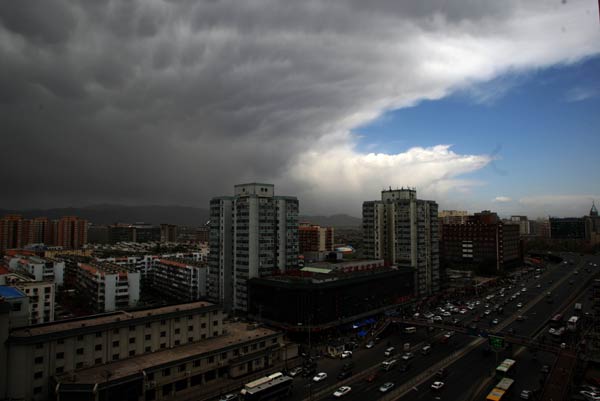Society
Forecast: Dusty weather to stay
By Zhang Yan (China Daily)
Updated: 2011-04-18 07:55
 |
Large Medium Small |
BEIJING - After calling off a sandstorm warning on Sunday evening, meteorologists forecast that dusty weather will persist in parts of the country on Monday.
 |
|
The sky turns dark as a sandstorm approaches Wanquanzhuang, in Beijing's Haidian district, at 11:30 am on Sunday. [Photo/China Daily] |
The National Meteorological Center of China said that sandstorms hit North China's Inner Mongolia autonomous region and part of Gansu province on Sunday.
The same day brought dust to parts of Ningxia Hui autonomous region, of Shaanxi, Shanxi and Hebei provinces and of Beijing and Tianjin municipalities - all in northern China.
Along with the dust, those areas saw temperatures drop from 6 C to 8 C, according to the center.
| ||||
It was the fifth sandstorm to hit China this year. The National Meteorological Center of China issued a warning on Saturday in anticipation of the inclement weather.
Zong Zhiping, chief meteorologist at the center, told China Daily on Sunday that the storm resulted in part from the melting of frozen soil and snow - which allowed sand particles to be picked up more easily by the wind - and from gusts of cold air that are common in the spring.
Finding signs that the storm would weaken by Sunday afternoon, the National Meteorological Center of China decided to cancel the warning at 6 pm that day.
Even so, Zong said it is likely that more sandstorms will sweep across China in the near future.
"We are entering the sandstorm season," he said. "Most of the sandstorms in this country happen in spring, especially from March to May."
In 2010, 19 sandstorms swept across China. Sixteen of them occurred from March to May, and three during October and December, according to a center researcher surnamed Xu.
The strongest sandstorm seen this year was also the first to hit the country. In March, most of North and Northwest China, including Xinjiang, Qinghai, Gansu, Inner Mongolia and Ningxia, bore the brunt of a strong sandstorm for three days.
Meteorologists advised the public to close doors and windows and to wear masks and scarves when going out.
And for three minutes on Sunday afternoon, hail and gales hit the Shunde and Nanhai districts of Foshan city, in South China's Guangdong province.
China Central Television reported that the strong winds pulled trees out of ground and blew a newsstand more than 20 meters away from its original location.
According to the publicity department of the Nanhai district government, more than 40 electricity poles and more than 100 trees were snapped, and the roof of a 60,000-square-meter factory building was destroyed. Initial estimations put the economic losses from the storm at 50 million yuan ($7.7 million).
Some local residents said the damage resulted from a type of tornado, but the local meteorological department has not attested to the accuracy of their characterization of the storm.
| 分享按钮 |



